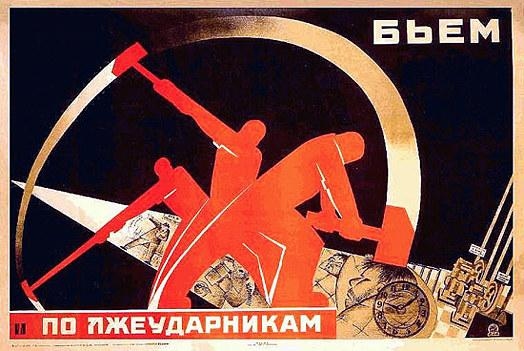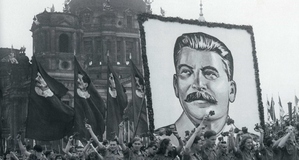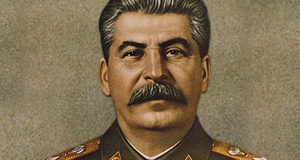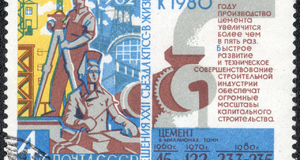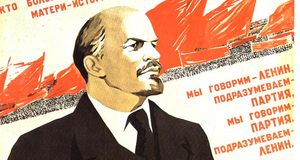Featured Article:Stalin and the Drive to Industrialize the Soviet Union
By
2009, Vol. 1 No. 10 | pg. 1/1
KEYWORDS:
The late twenties and early thirties were perhaps the most transformative period in Soviet history. It was during this period Stalin consolidated his grip on power and was allowed to rule with impunity, instituting his “revolution from above” on the Soviet people. He actively transformed the culture of the time, giving birth to a new Russian nationalism, rejecting the earlier Bolshevik conviction that the family was a bourgeois institution, and even forcing artists and writers to embrace “socialist realism.” These cultural changes were, however, minor adjustments when compared to the vast changes his economic policies brought to the everyday lives of the Russian people. Through the brutal process of collectivization he destroyed the autonomy the Russian peasant had enjoyed since the revolution, and he led an industrialization drive that has had few historic parallels. The human costs of both these initiatives were monstrous. It was during industrialization that the Soviet Union became truly totalitarian. Industrialization was the main component of Stalin’s revolution. All the leaders of the Bolshevik revolution understood the inherent problem in starting a communist revolution in Russia: the country was not sufficiently capitalist to become socialist, and subsequently, communist. The transition from the old Russia to a truly communist state would require industrialization on a massive scale.
According to Marxist theory, only through a modern industrialized economy could a true proletariat class be developed as Marx makes no mention of a peasant class. Marxist theory aside, the need to industrialize was also a pragmatic matter of self-defense. Stalin, either as a result of paranoia or a simple distrust of the capitalist West, assumed his country would have to fight for its survival. He presented the need to industrialize as a life or death struggle. “Do you want our socialist fatherland to be beaten and to lose its independence?” he asked in a famous February, 1931 speech. “If you do not want this you must put an end to its backwardness in the shortest possible time and develop genuine bolshevik tempo in building up the socialist system of the economy […] We are fifty or a hundred years behind the advanced countries. We must make good this difference in ten years. Either we do it, or we shall be crushed” (Daniels, 182). Stalin saw increased centralization as the means to make the industrialization drive successful. “It is time to put an end to the rotten policy of noninterference in production. It is time to adopt a new policy, a policy adopted to the present times--the policy of interfering in everything” (Daniels, 182). At the outset of the first five year plan in 1929, Stalin instituted impossibly high production figures for factories to stir up zeal. As Kenez points out, the unrealistic optimism of these goals can be seen by the fact that many of goals party leaders choose for industries 1932 were not reached until 1960 (Kenez, 90). Realistic state planning went out the window. According to Kenez, “‘planning’ was reduced to naming target figures which had little more than propaganda significance” (Kenez, 90). The propaganda, however, was extremely successful in that it accomplished its goal: increased production. In the first five year plan, which ended in 1934, there was a fifty percent increase in industrial output with an average annual growth rate of eighteen percent, while the population of industrial workers doubled. Much of this success can be attributed to the zeal with which the workers approached their work; they were mobilized as if for war, and were willing to accept lower standards of living as sacrifice for building a modern industrial infrastructure and economy. John Scott, an American who worked building the city and factories at Magnitogorsk in the early thirties, describes the attitude of his coworkers in his book Behind the Urals. One man complains about the lack of food, then reverses course saying “But then – if we are going to build blast furnaces we have to eat less for awhile” (Scott, 13). Shabkov, a kulak, describes how his family’s property was arbitrarily taken and his brother murdered, only to conclude: “But then, after all, look at what we’re doing. In a few years now we’ll be ahead of everybody industrially. We’ll all have automobiles and there won’t be any differentiation between kulaks and anybody else” (Scott, 18). They all seem to share an acceptance of deprivation today in exchange for the utopia of tomorrow. In many ways they had reason for this optimism: society was fundamentally changing. In particular the industrial workforce was growing, as many peasants moved from the countryside into the cities to escape collectivization. Between 1926 and 1932 the urban population grew from 26 million to 38.7 million. Between 1928 and 1932 the number of employed jumped from 11.5 million to 24 million (Kenez, 93). Women also joined the workforce in large numbers. During the NEP years less than a quarter of the industrial workers were female, by the end of the 1930’s they made up forty percent of the industrial workforce (Kenez 94). The increases in production were dramatic. During the first five year plan (1929-1934) there was a fifty percent increase in overall industrial output and an average annual growth rate of eighteen percent. These statistics, however, do not take into account the poor quality of the goods produced. By emphasizing output only, and by intentionally setting the target output levels unrealistically high, the Soviet leaders created a system in which poor quality done quickly was preferable to producing quality products at a slower rate. Part of this had to do with the constant specter of the secret police hovering over the country, ready to declare “treason when economists pointed out the irrationalities in [the] plans or argued that impossible goals were bound to create crises, which in turn led to waste and inefficiency” (Kenez, 90). There was also the problem created by an entire workforce learning the skills necessary to run the newly built factories and plants all at once. Many of the workers were from the peasantry and lacked any sort of education, and as a result, heavy industry was run inefficiently. Scott describes the inability of the workers to run the machinery they had been so busy building: “Semi-trained workers were unable to operate the complicated machines which had been erected. Equipment was ruined, men were crushed, gassed and poisoned, money was spent in astronomical quantities” (Scott, 137). The waste and inefficiency that plagued the struggle to make heavy industry work left over few resources for light industry and consumer goods. Shelves in stores were often bare. According to Scott, “the size of the pay envelope, the number of bank notes under the mattress, no longer determined living standards. Everybody had money, but what one ate or wore depended almost exclusively on what there was to buy in a particular store to which one was attached” (Scott, 42). Kenez emphasizes this point when he writes that “real wages of 1932 were only about half of what they had been in 1928” (Kenez, 95). Living conditions also remained abysmal. As workers poured into the cities a serious housing shortage emerged. Often multiple families were forced to share small rooms (Kenez, 96). Still, despite all its failures, the rabid industrialization did close the gap between the Soviets and the West, and it is doubtful anything short of this kind of mass mobilization would have given Russia the means to withstand the Nazi onslaught a few years later. The successes the industrialization drive did enjoy were the results of the transformation of the Russian agricultural system and the exploitation of the peasantry. Industrializing Russia required purchasing large amounts of foreign machinery and feeding a growing workforce, both of which required large amounts of grain. In the end, the peasants were forced, oftentimes violently, to subsidize the industrialization of Russia by giving up larger and larger amounts of their grain while gaining nothing in return. Stalin called this a “supertax” on the peasants, but was convinced it was necessary (Daniels, 171). In a speech to the Central Committee in April of 1929, Stalin insisted that the state must use new measures in order to expedite the process of “obtaining from [the peasants] the maximum grain surplus necessary to be able to dispense with imported grain and save foreign currency for the development of industry” (Daniels, 172). Obtaining the maximum amount of grain would require a whole new agricultural system. As Peter Kenez notes, grain production at the end of the NEP era, a time in which peasants were encouraged to sell their grain and create markets, was still only ninety percent of what it was in 1913, but more importantly, the amount of grain that made it to the market was only half of what it was before the revolution. (Kenez, 82). The problem was that most of the large estates that produced grain for the market had been destroyed in the Bolshevik takeover, and that the government kept grain prices low. The result was that peasants sold their grain to NEP men and others who offered better prices than the government (Kenez 82-3). Stalin saw the deficiency in the agricultural system as “small-peasant farming, which provides a minimum amount of grain for the market” (Daniels, 160). The solution, he said, “lies in the transition from the small, backward and scattered peasant farms to amalgamated, large scale socialized farms […] the way out lies […] in expanding and strengthening the old state farms, and in organizing and developing new, large state farms” (Daniels, 161). The collectivization process began in 1927, at which time the decision to move onto collective farms was voluntary. Few volunteered. In 1928 less than one percent of all arable land was farmed by collectives; by 1929 barely more than seven percent of the peasant households were collectivized (Kenez, 85). After Stalin defeated all political opposition, however, collectivization became mandatory, and increasingly violent. By the spring of 1930, the proportion of collectivized household skyrocketed to sixty percent (Kenez 85). The process of rapid collectivization was made possible by Stalin’s war on the Kulaks. Like Lenin before him, Stalin saw the kulaks, vaguely defined as wealthy peasants, as unacceptably capitalist. (Paradoxically, the regime was punishing those who were most successful under the NEP system.) By initiating a war on the kulaks, Stalin’s regime succeeded in dividing the peasant class, making them less likely to resist collectivization. The attacks on the Kulaks also helped make the impression that it was only the Kulaks that resisted collectivization, presumably because they were not imbued with enough “class consciousness” and enjoyed exploiting their neighbors. And since kulak was so loosely defined, anyone who resisted collectivization could be quickly labeled a kulak. As was always the case in Stalin’s Russia, terror was the most convincing means of coercion. Kulaks were sometimes killed, sometimes sent to Siberia, but always had their property taken. Local districts were required to fill quotas of Kulaks to identify (Kenez, 86). Kenez sees the violence of this time as collectivization’s most significant precedent: “Mass murder for vaguely defined political goals became a possibility – this was the most important legacy of collectivization” (Kenez, 89). Initially, the state endorsed the soukhoz, or state farms. These were owned and operated by the state, with wages paid to the peasants who worked their. Soon, however, the regime favored the kolhoz, or collective farms, in which the peasants lived and farmed together, and had to pay the state a proportion of their harvest, (usually around forty percent) which was more exploitive and therefore preferable since the peasants had to suffer whatever shortages arose, not the state. The peasants were also forced to pay a tax to the machine tractor stations, or MTS. Agricultural machinery was not given to individual farms, but kept in the MTSs, which were shared by several kolhoz. This furthered centralization, and gave the state even more power over the peasants, who now relied on the state for all aspects of their farming. The kolhozes were forced to hand over a percentage of their crops to the MTS for the use of its equipment, usually around twenty percent. The MTSs also had a political department that reported to a national body (Kenez, 98). The results of collectivization were not what the regime had hoped. Grain production declined ten percent between 1928 and 1932, and in addition delivery quotas were “two to three times higher than the quantities the peasants had previously marketed” (Kenez, 99). Starvation was rampant and between 1932 and 1933 the Soviet Union suffered a cataclysmic famine. The government did nothing to assist the starving, what little grain was harvested was brought to the cities: in effect the regime traded the peasants for the workers. Admitting to the horrors of the famine which was focused primarily in the Ukraine, the Northern Caucasus, and the Volga region (the Union’s “breadbasket”) would undermine the state’s commitment to collectivization. It is estimated that five to seven million people starved to death (Kenez, 100). In 1932, Stalin gave his “dizzy with success” speech in which he claimed that collectivization was such a success that it must be reeled in. At that time the largest of the farms were broken up into smaller ones, and the peasants were once again allowed private garden plots, which were more productive then the farms themselves. Although collectivization was somewhat of a failure in terms of grain production, it was a success in that it had solved the peasant problem that had confounded the Bolsheviks since Lenin. The peasants were no longer autonomous, there will was broken, and the power in Moscow now controlled Russia more completely then the Tsars could have ever dreamed. The mass mobilization under Stalin had costs millions of lives. Peasants, workers, the intelligentsia, and the party itself, thanks to the purges, all suffered losses that had been previously unequaled in the long and brutal history of Russia. If nothing else, the country was prepared for the sacrifices of World War II. But what may be the greatest casualty of the Stalin era was the dream of communism. Scholars will debate whether Stalin’s massive terror campaigns were the inevitable outcome of communism for many years, but what became clear during this period is that the violence employed by the Bolsheviks in taking power would only intensify. Communism could no longer claim to be an emancipating force, at least not in the eyes of a candid world. ReferencesDaniels, Robert Vincent. The Stalin Revolution: Foundations of the Totalitarian Era. New York: Houghton Mifflin, 1965. Kenez, Peter. The Birth of the Propaganda State. New York: University of Cambridge Press, 1985. Scott, John. Behind the Urals: An American Worker In Russia's City of Steel. Bloomington, Indiana: Indiana University Press, 1973. Suggested Reading from Inquiries Journal
Inquiries Journal provides undergraduate and graduate students around the world a platform for the wide dissemination of academic work over a range of core disciplines. Representing the work of students from hundreds of institutions around the globe, Inquiries Journal's large database of academic articles is completely free. Learn more | Blog | Submit Latest in History |

